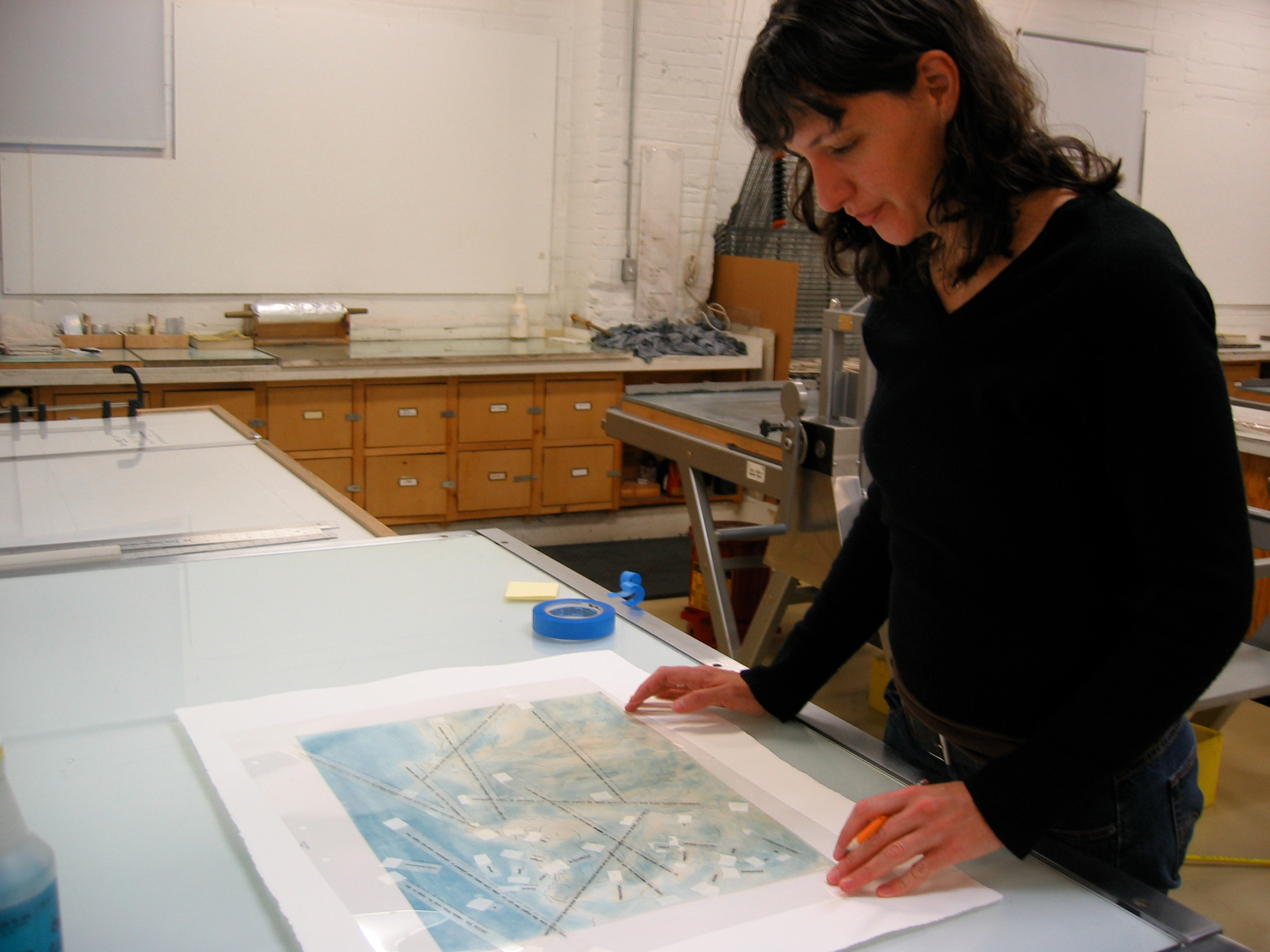
Born 1971, Sydney, Australia
Jessica Rankin came to prominence with her large panels of filmy organdy fabric that she covered with spidery lines resembling celestial maps, mountain ranges, or diagrams of urban roadways. Her drawing tool was embroidery thread, which had become her primary medium by the time she’d left graduate school. The compositions were punctuated with hand-sewn words or phrases—lines from mythology, poetry, songs, overheard conversations, or her own writing. Sometimes she would string words together all in capital letters, making them hard to decipher. In part, Rankin was attempting to capture thought, which she says can be diaphanous, choppy, and fragmented. “My work’s always had a lot to do with language and the landscape of the mind,” she has said.1 One critic observed that Rankin’s needlework “posits a disembodied consciousness floating through time and space.”2 For her 2008 Highpoint prints, Parade of Possibilities (cat. no. 246) and Reverberations (cat. no. 247) , which combine and , she applied typed words and phrases, like the strains of thought constantly forming in our brain.
Rankin learned to sew from a babysitter. Although her recent focus has been on painting , she still will add stitching to her compositions. As a child she made art in the studio of her father, the Australian painter David Rankin, “sometimes drawing and painting on his work,” she has said.3 Words were part of her childhood as well. Her stepmother is the writer Lily Brett. Her mother was the Australian poet and playwright Jennifer Rankin, who died when Jessica was eight years old. Her embroidered organdy panel Quis Est Iste Qui Venit (Who Is This Who Is Coming) (2012) approximates the night sky in New South Wales, Australia, on December 8, 1979, the date of her mother’s death. Another embroidery, Field of Mars (2016), takes its name from the cemetery where her mother is buried.
Rankin graduated with a history degree from Melbourne University, Australia, in 1993. She earned an MFA (1997) from Rutgers University, New Brunswick, N.J. Her one-person exhibitions include “The Nostalgia for the Infinite,” White Cube Bermondsey, London (2021), as well as shows at Carlier Gebauer, Berlin (2019, 2016); Savannah College of Art and Design, Atlanta (2013); The Project, New York (2009, 2004); and P.S. 1 Contemporary Arts Center, Long Island City, N.Y. (2006). Rankin exhibited jointly with Julie Mehretu in “Struggling with Words That Count” at Carlier Gebauer (2016–17) and in “Earthfold” at Museum Dhondt-Dhaenens in Deurle, Belgium (2016). Rankin has also had residencies in Melbourne, Austerlitz, N.Y., and Johnson, Vt. She is based in New York.
—Marla J. Kinney
Notes
. “Jessica Rankin: Mind and Language,” interview by Susan Sollins, Art21, filmed in 2008, video, 3:39, November 24, 2010, https://www.youtube.com/watch?v=CUtOVW8W6CY. ↩︎
. Matthew Guy Nichols, “Jessica Rankin at The Project,” Art in America, March 2005, p. 136, accessed June 18, 2021, http://www.jonathangilmore.com/uploads/1/1/6/1/11614915/dan_christensen.pdf. ↩︎
. “Jessica Rankin,” NewArtTV, video, 8:49, produced and directed by Robert Knafo, October 10, 2007, https://www.youtube.com/watch?v=nukNRr-aAJA&t=219s. ↩︎